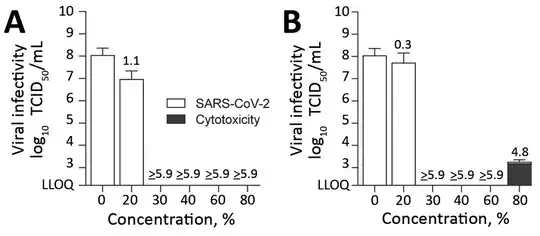A more recent study (also published by the CDC) seems to indicate that 30% might be a good enough concentration against SARS-CoV-2:

[Figure legend:] Effect of commercially available alcohols in inactivating SARS-CoV-2. The means of 3 independent experiments with SDs (error bars) are shown. A) Results for ethanol. B) Results for 2-propanol. Dark gray bar indicates cytotoxic effects, calculated analogous to virus infectivity. Dashed line represents limit of detection. Reduction factors are included above the bar. The biocide concentrations ranged from 0–80% with an exposure time of 30 s. Viral titers are displayed as TCID50/mL values. LLOQ, lower limit of quantification; SARS-CoV-2, severe acute respiratory syndrome coronavirus 2; TCID50/mL, 50% tissue culture infectious dose.
[...] Conclusions: [...] ethanol and 2-propanol were efficient in inactivating the virus in 30 s at a concentration of >30% (vol/vol). Alcohol constitutes the basis for many hand rubs routinely used in healthcare settings. One caveat of this study is the defined inactivation time of exactly 30 s, which is the time recommended but not routinely performed in practice.
Having said this, antiseptics and disinfectants (in general) are binned in roughly 3 categories based on what they can deal with. Mycobacteria (e.g. tuberculosis) and bacterial spores are a harder (and respectively a lot harder) to inactivate/kill than viruses. (Some antiseptics were even contaminated with mycobacteria.) So (besides possible non-compliance with the recommended use/rubbing time) this is a good reason to demand greater alcohol concentration in general-purpose alcohol-based antiseptics.
Furthermore, even just a far as alcohol effectiveness against viruses is concerned, a 2019 Japanese study of influenza A virus (IAV) inactivation by ethanol found that [non-dry] mucus constituted an extra protective layer for the virus (besides its own envelope), slowing the effect of ethanol-based disinfectants (EBDs) about eight times:
Our clinical study showed that EBD effectiveness against IAV in mucus was extremely reduced compared to IAV in saline. IAV in mucus remained active despite 120 s of AHR [antiseptic hand rubbing]; however, IAV in saline was completely inactivated within 30 s. Due to the low rate of diffusion/convection because of the physical properties of mucus as a hydrogel, the time required for the ethanol concentration to reach an IAV inactivation level and thus for EBDs to completely inactivate IAV was approximately eight times longer in mucus than in saline. On the other hand, AHR inactivated IAV in mucus within 30 s when the mucus dried completely because the hydrogel characteristics were lost.
(30s is the hand-rubbing typically recommended for antiseptics when used as hand sanitizers.)
